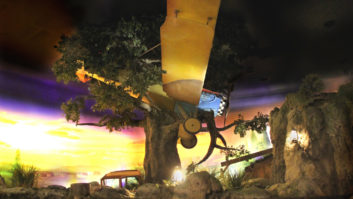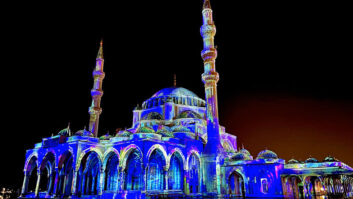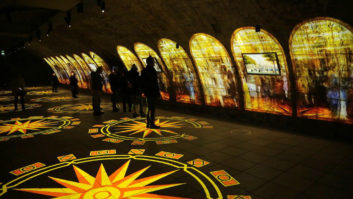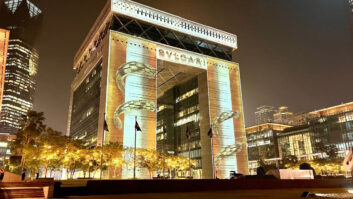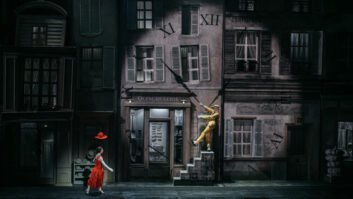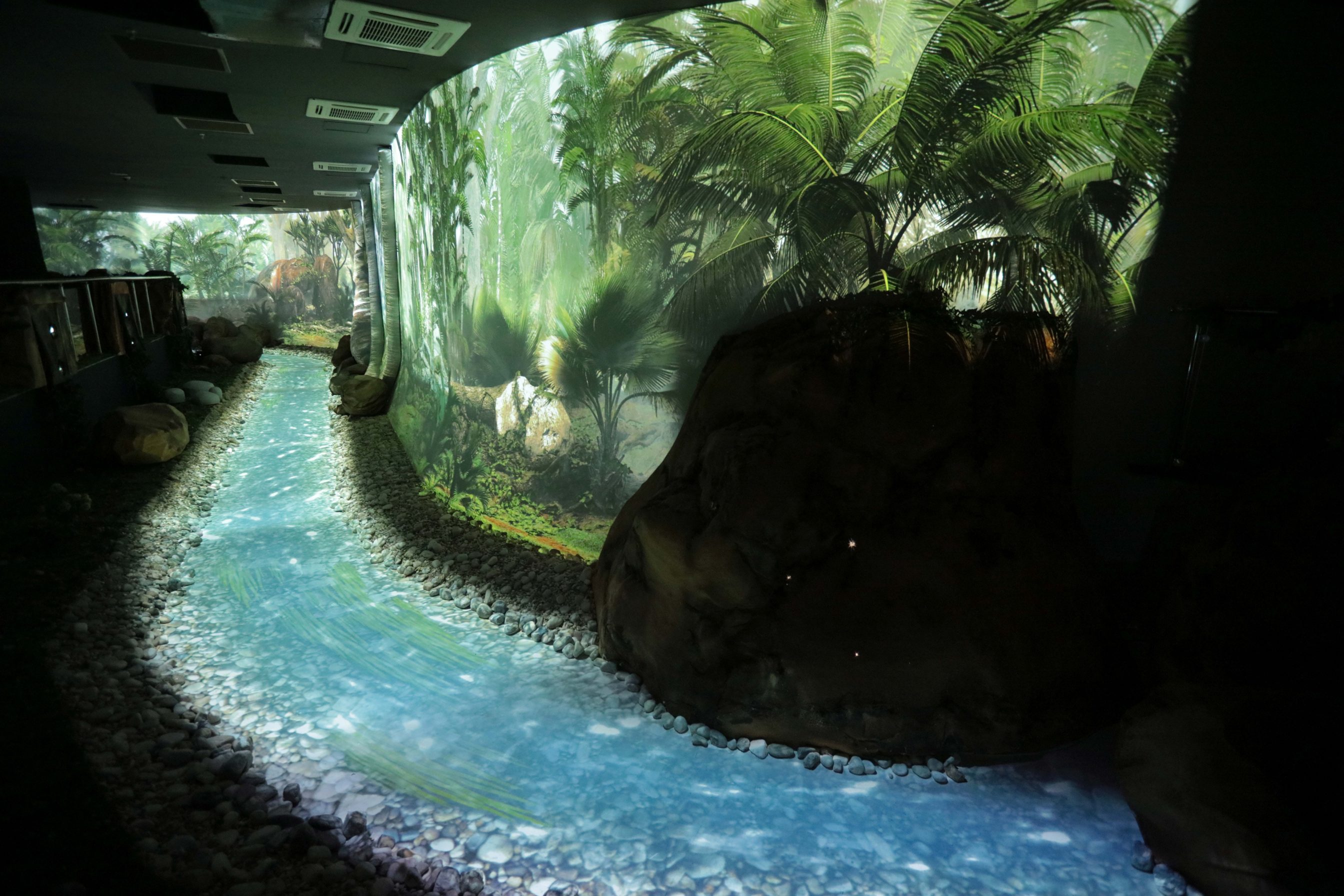
Projection mapping can’t be described as a mission-critical AV application – but it does show the industry at its brilliant best. To kick off this special report, Ian McMurray finds out the direction in which mapping is headed.
In the UK at least, the world seems to divide into two: those who arrange their entire lives around watching Game of Thrones on TV – and those who have never seen a single one of the 68 episodes broadcast to date. Season 7 premiered on 16 July – an event marked, in true Hollywood style, by a projection mapping extravaganza which saw Panasonic projectors provide a backdrop to the party, delivering scenes from the series onto the exterior of the Walt Disney Concert Hall in Los Angeles.
A simple definition of projection mapping is that it’s a combination of technologies that are used to turn objects that are often irregularly shaped into display surfaces. As Hans Stucken, global marketing manager of media and control systems company AV Stumpfl points out, it’s something of which many projectors are now, in theory, capable to a certain degree.
“A number of projector manufacturers are adding features to their projectors that allow for simple projection mapping set-ups,” he says. “However, we have to make a distinction between simple geometry adjustments for creating softedge panoramas on uneven surfaces on the one hand and, on the other, fully blown and highly intricate mapping projects featuring 3D files and physical objects with surfaces that are very detailed and uneven. Both scenarios, and everything in between, can be called projection mapping.”
For the majority of the industry, the latter description more accurately defines what is meant by projection mapping, and involves a combination, in most cases, of high-end projectors with powerful media servers and software. It’s developments in both that are driving the projection mapping market to new heights – driven by the creative vision and technical expertise of its exponents.
Without doubt the stability and longevity that laser projection technology brings has been one of the most significant developments
Mark Wadsworth, Digital Projection
Transformative
According to Mark Wadsworth, international marketing manager at Digital Projection, the advent of 4K SSI (solid state illumination) projectors has been transformative.
“The large majority of high-end projectors include warp functionality that is the cornerstone of any projection mapping installation,” he believes, “Without doubt, however, the stability and longevity that laser projection technology brings has been one of the most significant developments. We’re now seeing projectors in the market, capable of up to 30,000 lumens, that are perfectly suited to large projection mappings on all kinds of irregular surfaces in almost any environment. Coupled with the ability to mount laser phosphor projectors in any orientation, mind-blowing mapping solutions have become exponentially more accessible and achievable than ever before.”
Wadsworth also points out that the advanced features required in a projector to support mapping are becoming more accessible and easier to use – and that ease of use is further enhanced by the ability to control multiple projectors and access all their features from a central location.
Carl Rijsbrack, VP, events at Barco, sees other advantages for the new generation of projectors. “Use of high-brightness laser phosphor projectors allows long-term installations for projection mapping without lamp change and with a much longer service interval,” he notes. “Beyond that, availability of more pixels with 4K resolution gives more detail on larger surfaces from a single video projector, as well as providing overall lower set-up time. The advent of both laser-based light sources and 4K resolution is bringing new dimensions to projection mapping.”
Paul Wigfield, director of projection mapping and 3D projection specialists QED, sees those advantages from a user perspective.
Important step forward
“One 4K projector can replace four blended HD projectors,” he states, “so under the right circumstances, it can substantially reduce the numbers of projectors required.”
He’s also seen an important step forward in media servers. “The introduction of the VFC cards for d3’s 4x4pro media servers has been one of the most significant technical developments,” he claims. “This not only allows 16 simultaneous HD outputs to be played from one media server, but it also enables different resolutions to be genlocked. This means that it is now possible to seamlessly utilise any combination of projectors in a projection canvas without being tied to the lowest common resolution.”
“For all media servers, the introduction of the open source HAP codec has improved the quality and efficiency of video playback,” he continues, “and also brought a big benefit for planning and general workflow as it’s playable on all operating systems.”
Matt Barton, CEO at 7thSense Design – which developed Delta Media Server – is excited by what he sees. “Now, the boundaries of projection mapping technology are continually being pushed,” he enthuses, “and we’re seeing real developments and a demand for mapping onto increasingly complex 3D shapes, and onto moving objects – both within the ‘display space’ and rotationally.”
New things achievable
“Projection mapping methodology has seen a shift too,” he goes on. “Now, it’s an automated process achieved by importing models into the software and automating alignment between the real and the virtual object. Removing the need for manual, complex alignment has made new things achievable and quick to turn around.”
The use of cameras in projection mapping is also becoming increasingly commonplace. “A complex mapping solution will always require the ‘smarts’ of additional software that can be integrated with camera and auto-calibration tools,” notes Wadsworth. “We’ve teamed up with various specialist partners to offer this functionality. Specialist servers and software bring together the essential ingredients for mapping, namely camera-based shape recognition and auto-calibration for blending that dramatically speeds up the process and accuracy of any mapping installation.”
“A significant development has definitely been the availability of sophisticated automatic camera calibration solutions like Wings VIOSO technology for projection mapping projects,” adds Stucken. While the mapping functionality built into projectors continues to be enhanced, there is little doubt that the role of the media server remains key.
www.7thsensedesign.com
www.avstumpfl.com
www.barco.com
www.digitalprojection.co.uk
www.qedproductions.com

